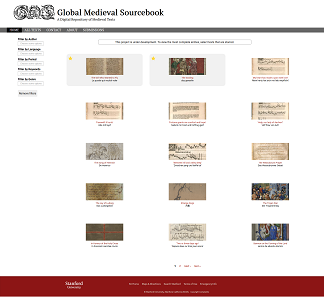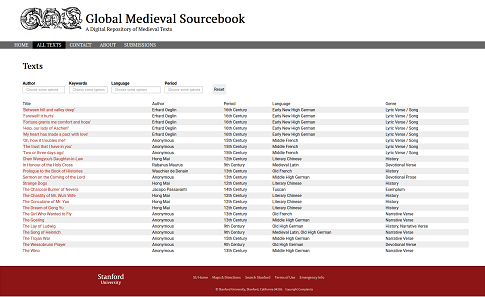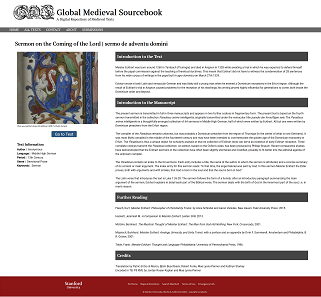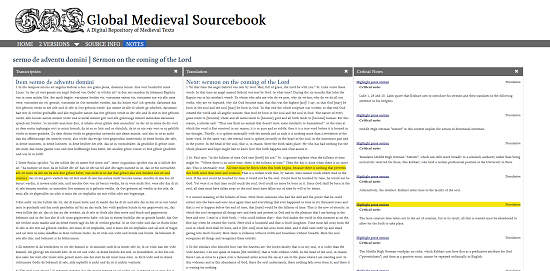by Annika Backe
January 11, 2018 – What does a modern person do when searching for medieval texts? He or she asks the internet – only to fall into despair, for there is no translation available for many of the sources or the mentioned reference book can only be accessed in a library.
“Global Medieval Sourcebook – A Digital Repository of Medieval Texts”.
Recognizing the need for action, venerable Stanford University has created a free and open access database containing medieval texts. This “Global Medieval Sourcebook – A Digital Repository of Medieval Texts” currently lists 24 written sources, with many more to come.
Overview of the texts recorded in the database so far.
The GMS aims at spanning an entire millennium of literary production across the medieval world; covering Europe as well as North Africa, the Middle East and Asia, from AD 600-1600. Sources are selected with respect to a manageable text length and their interest to various user groups.
Search in individual categories.
Searching is rather easy. You can either have a look at all the texts listed, in order to make your choice. Also, texts are searchable by author, language, period, keyword or genre. After clicking in one of these search fields, the user can choose from already existing keywords.
Database entry: Meister Eckardt’s “Sermo de adventu domini”.
After choosing, let’s say, Meister Eckardt’s “Sermo de adventu domini”, you will be directed to the main entry. It consists of a manuscript illustration and information on the source in a standardized format, followed by a short introduction to the life and work of this German theologian and philosopher (1260-1328). Then there is the introduction to the text manuscript, rounded out by a short list of selected resources – most of them are written in English – for further reading, and information on the ones responsible for the text’s transcription and translation.
Overview with transcription, translation and critical notes.
What makes the “Global Medieval Sourcebook” so special becomes apparent when you click the “Notes” tab. In contrast to a book that lists the critical notes as footnotes – or endnotes which is even worse –, in the GMS, you can view the critical notes alongside of the source’s transcription and translation.
The online compendium addresses pupils, students, teachers, academia and everybody interested. It invites researchers throughout the world to contribute and submit further texts for inclusion. The transcriptions, translations, and comments in the GMS are produced and reviewed by Stanford University’s scholars of Medieval Studies.
So, anybody who used to fall into despair when looking up medieval texts, and new English translations, on the internet can now draw on the “Global Medieval Sourcebook” as a user-friendly teaching and research tool.
To have a look at the GMS, click here.
This is the GMS entry for Meister Eckardt’s “Sermo de adventu domini”.
If you want to submit texts, too, access this link.









